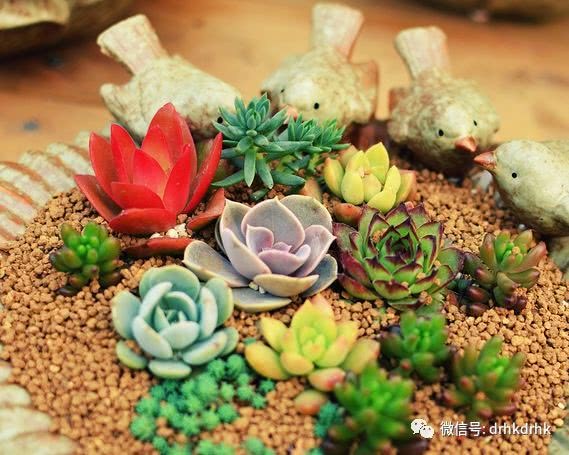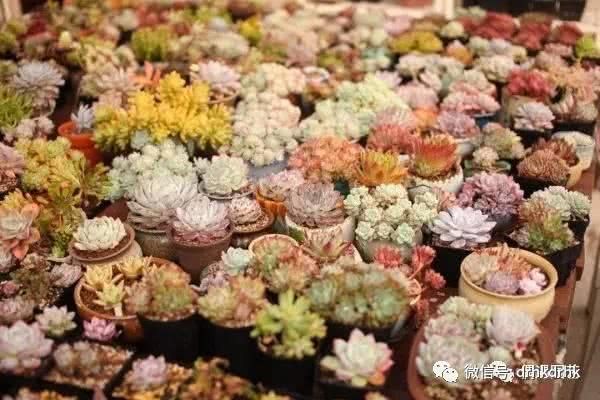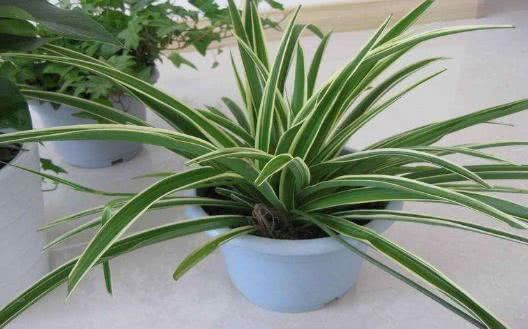The terminology of succulent plants should be professional.

Maybe many meat lovers have been raising succulent plants for some time, but some common succulent terms are not worth knowing. I hope this article will give meat lovers some understanding of the basic terms about succulent plants.
1. Succulent plants (succulent plant), also known as succulent plants and succulent plants, are ornamental plants with succulent stems and leaves and thick water storage tissue. Succulent plants with succulent stems such as cactus and succulent succulent plants such as tequila, crassulaceae and Euphorbiaceae. Lovers of succulent plants also like to call it "meat" for short.
2. Family name (family) the academic term of the plant taxonomic unit. Any genus or genera with similar morphological structure of flowers can form a family of the plant taxonomic system. The family Sedum consists of 30 genera.
3. Genus name (genus) the academic term of a plant taxonomic unit. Each botanical name must be composed of a genus name, a species name and a nominee. Each subordinate may include one or more species.
4. Species) the academic term of a plant taxonomic unit, also known as a scientific name, in which each plant has only one scientific name. After the genus name, before the variety or cultivated variety name. For example, aloe (Aloe vera var.chinensis), where Aloe is the genus name, species name var.chinensis is the variety name.
5. Taxon under species and subspecies of variety. For example, the caterpillar-like ball in the cactus family is a variety of ctenophore, and the wild thorn is a variety of gold bluff, and so on.
6. The succulent part of the stem succulent plant (caudex succulent) is mainly at the base of the stem, forming dilated succulent masses or globules with different shapes. Such as Beijing maiko, Oval leaf kapok, Guangtang and so on.
7. Heterothallism means that unisexual flowers are planted on different plants, which leads to the distinction between male and female plants.
8. Hermaphroditic flowers (hermaphrodite flower) have both stamen and gynoecium in one flower. Most succulent plants are bisexual flowers and can bear fruit normally after flowering.
9. Simple,solitary means that the stem of the plant grows alone without branching and sterile bulbs. Such as Weng Zhu and Jinliu in the cactus.
10. Clustering refers to many dense new branches or bulbs growing together. Such as Songxia in cactus, Xi Zhi Pagoda in succulent plants, etc.
11. Dormant (dormancy) plants are in a state of natural growth standstill, and the phenomenon of fallen leaves or aboveground death will occur. It often happens in winter and summer.
12. The succulent plant in which the summer type (summer type) grows in summer and dormant in winter is called summer or hibernating plant. The main time of flowering is in summer. Summer here refers to the summer climate in which the meat is of origin. If the weather is too hot, the meat will still be dormant.
13. Winter type species (winter type) grow in winter and dormant in summer, which is called winter type plant or summer dormancy plant. Winter here refers to the winter climate in which the meat is in its place of origin. if the death rate is too cold, the meat will still be dormant.
14. Climbing stem (climbing stem) A stem that grows upward by climbing something else by special structure. Such as crassulaceae in the bird of paradise, sweet potato spinach in the tortoise shell dragon, and so on.
15. Aerial root (aerial roots) the root that grows from the aboveground stem is often seen on the adult plants of Hongzhiyu and Mei Rabbit ear.
Soft leaves (soft leaf) some species of leaves in succulent plants that are tender and succulent and are easily broken or damaged by diseases and insect pests. It is generally known as the soft leaf system, such as the jade dew in the 12-volume genus.
17. Thick leaf refer to some species of succulent plants with thick and hard leaves. It is generally known as the hard leaf system, such as the glazed hall in the 12-volume genus, the striped 12-volume and so on.
18. Rosette foliage (rosette) refers to the growth form of radiating clusters of leafy leaves on short stems close to the ground, and its leaves are arranged in a manner similar to that of lotus flowers. Such as crassulaceae of the stone lotus genus, windmill grass and so on.
19. Leaf-teeth often refers to the fleshy spines at the edge of the leaves of succulent plants. It is common in the genus Aloe of Liliaceae, such as the city that never sleeps, the brocade city that never sleeps, the emerald hall and so on.
20. Leaf thorns (leaf thorn) are transformed from some or all of the leaves into thorns, which can reduce transpiration and play a protective role. For example, the thorns of cacti are leaf thorns.
21. Window) many succulent plants, such as the 12-volume genus of Liliaceae, have transparent or translucent parts at the top of their leaves, called windows. The change of the window surface is also the basis for the classification of varieties.
22. Absorptive bud, also known as nie, is the bud produced on the node of the underground stem or in the axillary bud of the aboveground stem. Such as evergreen grass, stone lotus and other mother plants beside the small plants.
23, leaf scar (leaf scars) the petiole scars left on the stems and branches when the leaves fall behind. The arrangement order and size of leaf scars can be used as a basis for identifying plant species.
24. Hybridization the act of crossing two plants in order to obtain new varieties with two parental characteristics. For example, white peony is an intergeneric hybrid between Liriodendron and windmill.
25. Grafting (grafting) A method of propagation in which the stems and bulbs of the mother plant are attached to the rootstock to form a new plant. The stem, protuberance, or bulb used for grafting is called scion, and the plant that bears scion is called rootstock.
26. The rootstock (stock) is also called Taimu. A plant that meets a scion when it is grafted and propagated. In the grafting of cactus plants, Tianchi is widely used as rootstock, while succulent plants often use Bawang whip as rootstock.
27. Leaf cutting) A method of propagation in which part of the leaves of succulent plants are inserted into the substrate to promote rooting and grow into new plants.
28. Renewal) to promote the growth of new branches by means of pruning, including re-pruning and cutting off old branches.
29. Air-cured root (root drying) when the soil is too wet and root diseases lead to rotten roots and yellow leaves, the plants can be taken out of the soil and the roots can be exposed to air to dry, which is conducive to the eradication of bacteria and recovery of vitality.
30, brocade (variegation), also known as colorful spots, spotted brocade. The whole or part of the stem lost the function of producing chlorophyll, while other pigments were relatively active, resulting in red, yellow, white, purple, orange and other colors or spots on the stem surface. F.vataegata or 'Variegata' is often used in the name of the product.
31. Fasciation, or crown, is an irregular budding phenomenon. The affixation of this malformation is the result of the abnormal development of some meristem cells, and its scientific name is often written with f.crmata or "Cristata".
32. Coronal (cristate) leaves, stems or flowers grow in the shape of a chicken crown, also known as a chicken crown, such as peonies.
33. Bud mutation) the character of a plant vegetative body that is different from the original plant, can be inherited and preserved by asexual reproduction. Such as many spotted brocade and flattened varieties in succulent plants.
34. Mutation refers to the sudden change in the genetic tissue of the plant, which makes the plant appear new characteristics, and this new characteristic can be inherited in the offspring. Succulent plants can also fix new features by grafting.
35. Yellowing refers to the phenomenon of discoloration and yellowing of leaves and excessive growth of stems due to lack of light.
- Prev

How to make succulent plants grow faster? Why don't you learn quickly?
If you want to make succulent plants grow fast, nutrition is the key, while there is nutrition, you can't grow only, so light is also a very important factor. Let's explain it one by one. Soil seedlings put peat + vermiculite with few particles. Release mud from adult plants.
- Next

These four kinds of plants are cheap and beautiful except formaldehyde artifacts. Don't be fooled.
These four kinds of plants are in addition to formaldehyde "artifact", cheap and beautiful, don't be fooled by people! Finally, the new home is decorated, but we can't move in in a hurry. Why? Because of the existence of formaldehyde. Formaldehyde can be regarded as letting.
Related
- Wuhan Hospital Iron Tree Blooming Result Was Instantly Frightened by the Gardener Master
- Which variety of camellia is the most fragrant and best? Which one do you like best?
- What is the small blue coat, the breeding methods and matters needing attention of the succulent plant
- Dormancy time and maintenance management of succulent plants during dormancy
- Minas succulent how to raise, Minas succulent plant pictures
- What are the varieties of winter succulent plants
- How to raise succulent plants in twelve rolls? let's take a look at some experience of breeding twelve rolls.
- Attention should be paid to water control for succulent plants during dormant period (winter and summer)
- Watering experience of twelve rolls of succulent plants
- Techniques for fertilizing succulent plants. An article will let you know how to fertilize succulent plants.

